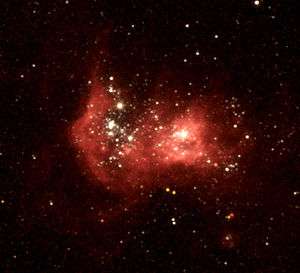NGC 2363
| NGC 2363 | |
|---|---|
|
A Hubble Space Telescope (HST) image of NGC 2363. | |
| Observation data (J2000 epoch) | |
| Constellation | Camelopardalis |
| Right ascension | 7h 28m 29.6s[1] |
| Declination | +69° 11′ 34″[1] |
| Redshift | 70 km/s[1] |
| Distance | 10 million light-years[2] |
| Apparent magnitude (V) | 15.5[1] |
| Characteristics | |
| Apparent size (V) | 1′.7 × 1′.1[1] |
| Other designations | |
| UGC 3847,[1] PGC 21078[1] | |
NGC 2363 is a star-forming region in the Magellanic galaxy NGC 2366 which is located in the constellation Camelopardalis. It contains NGC 2363-V1, a Luminous Blue Variable star which is 6,300,000 times more luminous than the Sun and one of the most luminous stars known. It can be seen in this Hubble Space Telescope image as the bright isolated star in the dark void on the left of the nebula.[3]
External links
References
- 1 2 3 4 5 6 7 "NASA/IPAC Extragalactic Database". Results for NGC 2363. Retrieved 2007-04-06.
- ↑ "Hubble Observes a Dwarf Galaxy with a Bright Nebula". ESA/Hubble Press Release. Retrieved 10 May 2012.
- ↑ Drissen, Laurent; Roy, Jean-René; Robert, Carmelle (1997). "A New Luminous Blue Variable in the Giant Extragalactic H II Region NGC 2363". The Astrophysical Journal. 474: L35. Bibcode:1997ApJ...474L..35D. doi:10.1086/310417.
This article is issued from Wikipedia - version of the 7/26/2016. The text is available under the Creative Commons Attribution/Share Alike but additional terms may apply for the media files.
